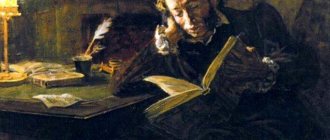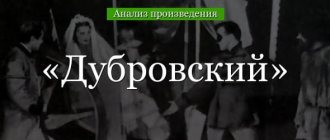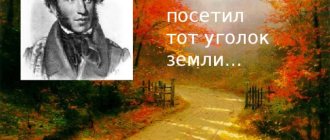Analysis of "The Miserly Knight"
The first of the “little tragedies” - “The Miserly Knight” - takes the reader to the Middle Ages. Its heroes are the old baron and his son Albert - knights, descendants of a once glorious, warlike family. But times have changed: young Albert is full of thoughts not so much about genuine military exploits, but about victories in court tournaments and success with secular beauties. The spear and helmet, from being formidable means of fighting an external enemy, turned into brilliant decorations in Albert’s eyes; concern for maintaining his dignity at the duke's court makes him dream of satin and velvet, and humiliate himself before the moneylender.
Compared to the ardent and generous, but at the same time sharing the tastes and prejudices of the court, Albert, his father, the old baron, is a man of a more integral era, going back into the past. This is a strong, unbending nature, cut as if from one piece. But the old baron is a ruthless usurer and miser, whose stinginess has taken the form of a kind of tragic mania. The old baron treats the piles of gold growing in his chests as an ardent young lover and at the same time as a poet, before whose eyes a whole world unknown to other people is revealed. Each doubloon he accumulates is not something impersonal for the baron; it appears to him as a clot of human sweat, human blood and tears, and at the same time a symbol of his gloomy and solitary power, based on the power of money. In the baron’s monologue, in a gloomy dungeon, where he is alone, in the glare of lighted candles, enjoying the contemplation of his wealth, Pushkin with exceptional poetic power outlined his strong, unbending character, the ugly, tragic passion that burns and drains him.
Analysis of the tragedy "Mozart and Salieri"
In the second tragedy - “Mozart and Salieri” - Pushkin took advantage of the widely spread legend about the death of the great Austrian composer Mozart, separated as if out of envy by his friend, the Italian Salieri. On the basis of this legend, Alexander Sergeevich built a deep philosophical drama of enormous intellectual tension. Salieri of his tragedies is a gifted musician, fanatically confident that nothing exists and should not exist in the world against which solitary and constant human labor and cold, strict mathematical calculation would be powerless. Salieri perceives the personality of Mozart and his brilliant music with its universal accessibility, beauty and humanity as a kind of “miracle” that refutes the entire edifice of his life as a person and musician. By poisoning Mozart, Salieri sacrifices him to his life principles and the harmony of his theoretical constructs. But the attempt to establish them at the cost of crime turns into a moral defeat for the dry, selfish, rational Salieri, and a victory for the deeply humane and cheerful Mozart, addressed to the world and people.
Analyzing the character of Shakespeare’s Othello, Pushkin noted: “Othello is not jealous; he is trusting." In his “little tragedy,” Pushkin subjects the character of Salieri to the same complex analysis. Pushkin's Salieri envies Mozart, but not because he is envious by nature. His feelings for Mozart stem from the painful awareness of the falsity of that path in art, in the name of which Salieri became an artisan, “killing” sounds, dismantling music “like a corpse.” A gifted person and musician, Salieri in his soul, more than anyone else, is aware of Mozart’s superiority over himself, feels the truth and power of his art. But this is what makes him suffer painfully, giving rise to envy and hatred of his younger and happier rival.
In “Mozart and Salieri,” Pushkin expressed his moral ideal: the words of a spiritually broken man after the crime of Salieri: “Genius and villainy are two incompatible things” affirm the idea of the incompatibility of art and crime, of moral purity and spiritual nobility as integral qualities of a true man of art, without whom he is inevitably condemned to creative sterility.
Cycle of small tragedies, history of creation, issues
4
(1)
Why are these dramatic plays, written by Boldinskaya in the fall of 1830, combined into one cycle?
Let's look carefully at the names of the tragedies and see that the title of each play already contains a certain conflict.
“Stingy knight”, a true knight had virtues, among which stinginess has no place. Stinginess and chivalry, like genius and villainy, are incompatible concepts.
"Mozart and Salieri." The fact that Mozart was poisoned by Salieri was already in doubt during the time of Pushkin, but until now the use of these names side by side sounds like the personification of a genius and his killer. The changed original title “Envy... once again confirms the idea that the conflict inherent in the title is one of the threads connecting “Little Tragedies” into a single cycle.
"The Stone Guest" A guest is a visitor visiting someone in a friendly manner, or an invited outsider, but in neither of these meanings can a guest be made of stone. The combination is surprising due to its textual anatomy.
"Feast in Time of Plague". The feast is a celebration of fun, the plague is a celebration of death. Each tragedy is based on a well-known plot or text.
"Mozart and Salieri." In 1824, news appeared in the European press that the Italian composer Salieri, who was dying, had admitted to poisoning Mozart, who died in 1791. Poisoning in the tragedy is a fact, despite the dubiousness of Salieri’s confession in real life.
“The Stone Guest” is an interpretation of the famous plot of Tirso de Molina’s drama “The Mischief of Seville, or the Stone Guest” (XVII century). But this is not a translation, but truly the author’s interpretation, since the emphasis is shifted from mischief, from the plot to the main character: his death is monstrous precisely because it comes in a moment of happiness.
“A Feast in Time of Plague” is a translation of one of the scenes from J. Wilson’s famous drama “Plague City.” But here too, Pushkin made a number of changes that gave the play a new sound.
But with “The Stingy Knight” a strange, at first glance, thing happened that baffled the reader. Initially, the manuscript had the subtitle “From English,” and upon publication, Pushkin replaced it with an even more mysterious one: “Scenes from Chanston’s tragicomedy...” Scientists were knocked off their feet, but did not find a similar plot in the little-known English poet W. Shenstone (18th century). Maybe the reference to a non-existent text is not a joke of the great poet, but a desire to shift the emphasis from a plot that is not new?
Even without being an experienced Pushkin scholar, it can be noted that each play has an autobiographical motif: in the relationship between father and son in “The Miserly Knight” there is an echo of the clashes in Mikhailovsky between Pushkin and his father, who accused his son of wanting to kill him with words; the rumor about the poet's Don Juanism was one of the reasons for Natalya Goncharova's mother's refusal to marry; “imprisonment” in Boldin during the cholera epidemic, which Pushkin often called “plague” in his letters; like Mozart, the poet understood his genius.
We summarize by answering the problematic question. “Little Tragedies” are combined into one cycle, as they have much in common: the genre is tragedy; the conflict is already in the title; tragedies are based on a well-known plot or text; the interest is not in the plot, but in the author’s interpretation of it, that is, the main thing is not the event, but its psychological, philosophical interpretation; autobiographical nature of many motives...
4 / 5. 1
.
Analysis of "The Stone Guest"
The third “little tragedy” - “The Stone Guest” - was written by Pushkin based on the plot of an ancient Spanish legend about the clever and skillful seducer of women Don Juan, who was cruelly punished for his diabolical art. By the time “The Stone Guest” was created, this legend had gone through a number of dramatic adaptations, of which Pushkin was especially well known for Moliere’s comedy “Don Juan” and Mozart’s opera of the same name (from its libretto, Pushkin chose the epigraph for “The Stone Guest”). Each of these adaptations gave its own, original interpretation of the character of the central character, who in the 19th century, during the poet’s lifetime, sparkled with new, unusual colors in Byron’s famous poem. Pushkin's Don Guan is also not like his predecessors. This is a poet of love passion. Both in his love for Inese (about which Pushkin’s Guan tells his servant Leporello in the first scene), and later in his relationship with Laura and Dona Anna, Guan is alien to pretense, sincere, filled with genuine feeling. Don Guan is bold, courageous, eloquent, he is fascinated by risk and danger. He is characterized by an acute curiosity for life, inherent in a man of the Renaissance, a desire to try his luck in spite of dilapidated church and religious-moral dogmas. But the overflowing energy of a free, uninhibited personality is combined in him with indifference to the moral consequences of his actions.
Unlike the authors of other plays about Don Juan, Pushkin shows the character of the hero in motion. In him - the “obedient student” of debauchery, which Don Guan remained for a long time, by his own admission - lived a man with other, higher aspirations. Love for Donna Anna makes Guan “reborn”, to realize this other person in himself. But this “resurrection” occurs too late - the killer of the commander and Don Carlos dies. Having experienced a moment of pure, genuine happiness, he is morally defeated and must “uncomplainingly” give his life as payment.
The ideological and artistic originality of the cycle “Little Tragedies” by A.S. Pushkin.
“Little Tragedies” were created in Boldin in 1830, when a cholera epidemic was raging in Moscow (which was actually reflected in the plot of “A Feast during the Plague”). All the “little tragedies” that make up the cycle are reworkings, as Pushkin himself points out, of already known works or plots. However, there is a certain mystification here. In "The Miserly Knight" it is stated that this is a "Scene from Chanston's tragicomedy." But Chanston (Shenston) does not have such a play. There is no such work in English literature at all, i.e., this is a literary hoax. “Mozart and Salieri” is based on the famous legend about the poisoning of the great composer by an envious colleague. “Don Juan” is also a very common folk story, on which many literary works were created (Tirso de Molina, Molière, Byron). “A Feast in Time of Plague” is a creative adaptation of the English playwright J. Wilson’s “Plague City.” Wilson's play has 13 scenes, of which Pushkin chose one. Pushkin translated it completely, removed minor details, compressed the action, reduced the number of characters, introduced two songs - Mary and the Chairman, and changed the title.
The main pathos of “Little Tragedies”, and accordingly, what unites them into a single whole, is an attempt to show in different aspects the value of moral laws, their immutability. Pushkin shows several options for people’s departure from moral laws (for various reasons) and comes to the conclusion that any departure from the moral law leads to personality degradation; a person is deprived of the most important thing - the meaning of his existence. Pushkin, as it were, puts the moral law on one side of the scale, and alternately places human temptations on the other.
In The Miserly Knight, it's power. For Baron, stinginess and hoarding are not the goal. Gold and money for him are only the personification of power over people. It is not even power itself that is enough for him, but the awareness of his own strength, the possibility that “you just have to want...” Under the influence of this passion, a gradual degradation of the person in Baron occurs. Moral values are replaced by a thirst for power (also known as a thirst for money). As a result, there are no human traits left in the Baron, no human feelings - no love for his son (he even accuses him of trying to kill his father), no love for his neighbor, no compassion. His last thoughts before his death were about the keys.
In Mozart and Salieri it is glory. Salieri strives for fame all his life, but having achieved it, he understands that the nature of creativity is different - Mozart is an example of this. Creativity, according to Pushkin, is the embodiment of the joy of life, a feeling of the fullness of being. Salieri subordinated his creative activity to something completely different - for him the main thing is not creativity, but what this creativity gives - success, fame. In order to achieve recognition, he “tests harmony with algebra.” His creativity, based on temptation (fame), is not true creativity, but according to Pushkin, it cannot be such. It is precisely because the initial motivations in Salieri’s work were not moral that a vicious circle arises. Some immoral actions give rise to others. The thirst for fame creates in Salieri a dependence on the opinion of the crowd, deprives him of freedom, and without freedom no creativity is possible. It is natural that Salieri begins to envy Mozart. Mozart creates brilliant works, but precisely because he does not set fame and noisy success as his goal. What is incomprehensible for Salieri (Mozart stops to listen to a street musician), for Mozart is a way to feel free, to feel the fullness and joy of being. With his existence, Mozart refutes Salieri’s value system, and for Salieri (who has already violated the moral law by taking up creativity with an impure purpose), the solution seems self-evident - to poison Mozart. One of Pushkin’s central ideas is the idea that genius and villainy are two incompatible things. Villainy is the result of a wrong path, the result of a violation of the moral law; one goes towards villainy for quite a long time, gradually, and at first glance imperceptibly. Salieri's last thoughts were precisely about this - whether the “creator of the Vatican” was the killer. For Pushkin, the answer is obvious - no.
In “The Stone Guest,” Pushkin puts the will of the individual, the “ego” of the individual, on the scale opposite to the moral law. The philosophy of Don Juan is the philosophy of individualism (the individualist hero is the central character of romantic works, for example, in Byron’s “Don Juan”). However, in Pushkin the confrontation between the individualistic hero and universal moral laws is brought to the maximum. Don Guan deliberately tramples on them in order to feel his will and power. He opposes his will to God's providence, striving in his self-will to compare with God. This is precisely the pathos of The Stone Guest. It is no coincidence that Don Guan, having killed Don Carlos, immediately, in front of the murdered man, declares his love to Laura, and it is no coincidence that he flares up with passion for Donna Anna only after he learns that she is the widow of the man he killed. Deciding to seduce Donna Anna, Don Guan pursues a goal much greater than just the love of a mortal woman. This is his competition with God. The scene of the Statue's invitation to visit Donna Anna is proof of this. Don Guan skillfully manipulates people's consciousness, using, in particular, the moral law as bait. Seducing Donna Anna, he assures that under the influence of love for her he became a virtuous person, thus giving his victim the opportunity to reconcile in his soul the contradictions between passion and moral law - according to Guan, Donna Anna, reciprocating his love, instructs him on the true path, so it turns out that her love has an allegedly moral mission. The scene of the appearance of the Commander's Statue is the highest punishment for a “willful” person for trying to compete with God.
In “A Feast during the Plague,” Pushkin puts death on the opposite side of the moral law, the tangible embodiment of which is the Plague (it is no coincidence that Pushkin writes “Plague” with a capital letter - it is a symbol). The awareness of the inevitability of death haunts all living beings. The plague only exacerbates this feeling. The heroes of “The Feast…” seem to ask themselves and those around them the eternal question: what is the meaning of this life if sooner or later it will end anyway, everything will be dust, everything will be forgotten? A person who is not firm in his belief in the inviolability of moral laws, in their absolute value, is not able to resist in a situation where this issue has not been resolved for him. Walsing and his guests are having fun, indulge in debauchery and drunkenness, but there is little joy in all this - death is felt everywhere. And the main thing that makes them have fun is the fear of death. Their fun is not a feeling of the fullness of life, the joy of being, but an attempt to drown out the fear of death. Some consciousness of the value of moral laws still glimmers in the souls of those present (Mary’s song); Walsingham himself realizes that he is destroying his soul, that his spirit is ruined and is almost dead (hymn in honor of the Plague, conversation with the Priest).
Thus, “Little Tragedies” represent a kind of philosophical manifesto of Pushkin, a reflection of his ideas about creativity and the meaning of life.
Analysis of "A Feast in Time of Plague"
The last of Pushkin’s “little tragedies” - “A Feast in the Time of Plague” - is a brilliant adaptation of an excerpt from a (much weaker in the original) play by the English romantic playwright D. Wilson. From Spain (where The Stone Guest takes place), the poet takes the reader to medieval England. Against the background of severe hardships and disasters of a city stricken by the plague, Pushkin draws two opposite characters - the soft, thoughtful Mary and the strong-hearted, inspired Walsingham, who boldly, with open eyes, looks into the eyes of death and is ready to measure his strength with it. The structure of each of these characters is clearly revealed in the songs that Pushkin put into the mouths of Mary and Walsingham - sad and soulful in the first and menacing, full of power and stormy tension in the second.
The analysis presented above is based on the following source. Source: Pushkin. Dostoevsky. Silver Age. / Friedlander G.M. St. Petersburg: “Science”, 1995





